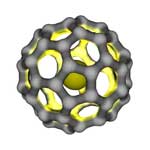 Nanoscience
is the study of the very small - things at the nanometer scale. This
is the scale of large molecules; molecular chains (like
plastics), proteins (from biology), nano-crystals (for example nanocrystalline
diamond) and new large molecules like fullerenes and nanotubes.
Nanoscience is essentially the physics and chemistry of objects at
the nanoscale. Nanoscience
is the study of the very small - things at the nanometer scale. This
is the scale of large molecules; molecular chains (like
plastics), proteins (from biology), nano-crystals (for example nanocrystalline
diamond) and new large molecules like fullerenes and nanotubes.
Nanoscience is essentially the physics and chemistry of objects at
the nanoscale.
Don't believe it if you hear the laws of physics no longer apply at
this scale - they certainly do! However they sometimes behave differently
to what we're used to at the human scale of things. For example, just
as if you look closely at a newspaper picture it starts to look like
lots of dots, so energies at the nanoscale and smaller can become quantised (split
into certain fixed amounts). As crystals get smaller the ratio of their
surface area to volume increases - many nano-objects are all surface
(all skin
and no custard!). This can be a useful property for catalysts, where
chemical reactions occur on their surfaces (nano-scale catalysts can
be extremely efficient).
If you want to find out more about nanoscience and nanoscale objects,
I have a new page of nanoscience related web
links. Otherwise here are a few of them you might want to try:
A la découverte du Nanomonde (en Français)
pdf brochure in French describing current research into nanoscience and nanotechnology with
good introduction describing the nanoscale.
Nano white papers
Executive summaries covering many new nanomaterials and the current
state of nanoscience.
The Next Big Thing - Nanotechnology
An on-line video from the Vega Science Trust where some of the world's top
nanoscientists discuss what it is and where it may be leading.
What is a carbon nanotube?
A carbon nanotube is a large molecule made of carbon atoms. The atoms are arranged in hexagons, much like chicken
wire, the same
arrangement as in graphite. However in graphite this 'chicken wire' lies in flat sheets on top of each other - in a nanotube the sheet is curled up into a tube.
Why does it do this? Because the carbon atoms at the edge of the sheet of graphite don't have enough carbon neighbours; by forming a tube the edges
are removed.
You can see these different structures here (note that a nanotube doesn't really form
by curling up in this way - they form directly as tubes from their constituent carbon atoms - this is just an easier way to see how graphite and carbon nanotubes are
related).
Notice that you have a choice over how you roll up the graphite sheet, depending on whether you connect together the top and bottom edges, or the left and right;
the same occurs in nature and the resultant nanotubes have different electrical properties. You can also attach the edges directly or offset them, making a helical tube.
(you can see these variations with a sheet of paper).
If you want to see more objects from the nanoscale, feel free to have
a look around my nanoscience image gallery. All
images ©2003 Chris Ewels, please do not use without permission.
Credits.
|